Contact
Fish routinely experience environmental and physiological disruptions that interfere with their biological stability or homeostasis. Direct comparisons of metabolic recovery from different stressors such as warming, hypoxia, and exhaustive exercise are rare, though such comparisons could be valuable in uncovering the distinct or shared mechanisms for coping with physiological challenges and predicting their ecological implications. Assessing the relative threat imposed by different stressors is difficult, as stressors vary in their mechanisms, effects, and timescales.
This study applies the fact that acute exposure to different stressors can result in the same whole-animal outcome of loss of equilibrium (LOE) to (i) compare the metabolic recovery profiles of rainbow darters in response to high temperature, hypoxia, and exhaustive exercise and (ii) test the concept that LOE could be used as a physiological calibration for the intensity of different stressors.
Methodology
The study focused on rainbow darters (Etheostoma caeruleum), a widespread benthic species that routinely copes with the stressors of interest as a routine part of its life history. Adult fish were collected from the wild, housed in 10-L acrylic tanks in a 385-L rack system (Aquatic Habitats Z-HAB System) and used for experiments. Using stop-flow (intermittent) respirometry, oxygen consumption rates in an undisturbed, control group and in fish before and after exposure to warming-, hypoxia-, or exercise-based physiological challenges sufficient to induce LOE were tracked.
The study distinguished between resting and routine MO2 – the latter being representative of the “operational” MO2 of the fish. Routine MO2 was used as the baseline to calculate aerobic scope, total O2 debt and recovery time. Both resting MO2 and routine MO2 data were collected prior to the stressor trials. The recovery profile of fish exposed to warming, hypoxia or exercise were quantified through two metrics: total O2 debt and recovery time. Total O2 debt was determined by calculating the area under the curve of measured MO2 above routine MO2 over time. Recovery time was defined as the time required for MO2 to return to routine MO2 after reintroduction of fish to the respirometry chamber.
Datasets that passed a D'Agostino-Pearson normality test were analyzed with a one-way ANOVA with Tukey's multiple comparisons test. Datasets that did not pass the normality test were analyzed with a non-parametric ANOVA on ranks (Kruskal-Wallis test) with a Dunn's multiple comparisons test or a mixed effects model followed by a Sidak multiple comparisons test.
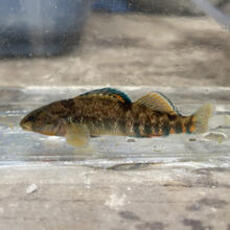
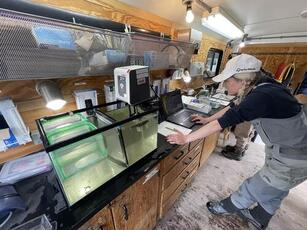
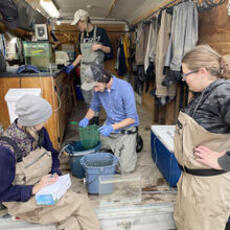
Outcomes
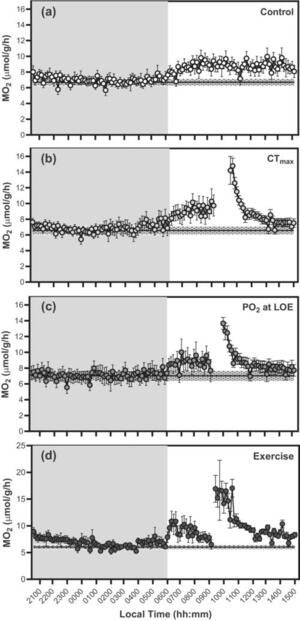
Figure 1: Whole-animal oxygen consumption rate (MO2). The dark phase of the photoperiod is indicated by gray shading. The thermal, hypoxia or exercise challenges occurred ~0900 to ~1100 local time, as indicated by the break in the of MO2 trace. The black horizontal line indicates the mean resting MO2 of each group, with the dot-shaded region indicating the standard error.
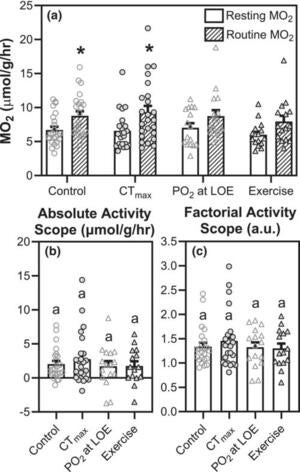
Figure 2: Diurnal variation in resting and routine oxygen consumption rate (MO2). (a) Routine MO2 immediately prior to the challenge window was consistently higher than resting MO2 during the overnight period, and this is reflected in factorial (b) and absolute (c) aerobic activity scope. Dissimilar letters indicate groups that are statistically different for each other; the lowercase “a” above all groups indicates that they are not different from each other. * indicates routine MO2 is statistically different from resting MO2 within that group.
All fish survived and successfully recovered from exposure to warming-, hypoxia- or exercise-based physiological challenges sufficient to induce LOE. Regardless of the stressor used, the fish recovered rapidly, returning to routine MO2 within about 3 hours. Fish recovering from hypoxia and warming had similar maximum MO2, aerobic scopes, recovery times and total excess oxygen consumption post challenge, while fish exposed to the exhaustive chase challenge had a 52% increase in maximum MO2, a 75% and 151% increase in factorial and absolute aerobic scopes respectively (Figure 3).
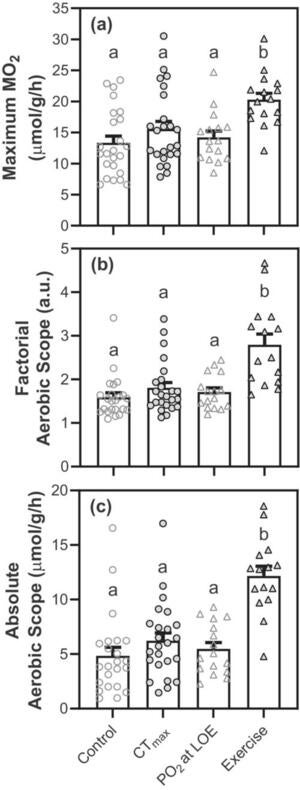
Figure 3: Maximum MO2 (a), factorial aerobic scope (b), and absolute aerobic scope (c) of fish recovering from a thermal, hypoxia, or exercise challenge that induced loss of equilibrium.
Fish recovering from a hypoxia or exhaustive chase challenge maintained elevated MO2 for longer periods than control animals (Figure 4). Although previous work has demonstrated that MO2 increases with temperature, this study may be the first to successfully track MO2 during recovery from a temperature trial and thus confirms the existence of an analogous excess post-warming oxygen consumption.
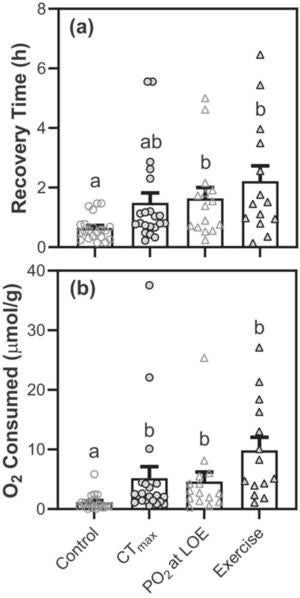
Figure 4: Recovery time and total O2 debt of fish recovering from a thermal, hypoxia, or exercise challenge that induced loss of equilibrium.
Conclusions
Characterizing the dynamics of metabolic rate during recovery has important implications for understanding the ecophysiology of fish. Extended recovery from natural- or human-induced challenges such as angling, wastewater exposure, or surmounting barriers can impact fitness by constraining the aerobic scope available for digestion, locomotion and reproduction. Quantifying and comparing the recovery processes is especially important in the context of multiple stressors. Prolonged recovery times effectively extend the effects of a stressor and put animals at an increased risk of interactive effects such as increased vulnerability to a subsequent stressor or the development of cross-tolerance.
The study found that rainbow darter showed considerable daily variation in MO2 and are capable of rapid recovery from severe warming, hypoxia, and exercise, which may reflect the physiological demands of its life history. Though exhaustive exercise induced a greater maximum MO2 than warming or hypoxia, all three stressors led to the same level of disruption and impairment. Thus, using LOE as an unambiguous and reliable indicator may be a viable conceptual approach for investigators interested in questions related to multiple stressors, cross tolerance and how animals cope with challenges to homeostasis. Future comparisons between excess post-exercise, hypoxia or warming oxygen consumption may explain the shared or distinct molecular biology, biochemistry or physiology involved in coping with environmentally relevant stressors.
Read more in the Journal of Fish Biology
Borowiec, B. G., Firth, B. L., Craig, P. M. Oxygen consumption rate during recovery from loss of equilibrium induced by warming, hypoxia, or exhaustive exercise in rainbow darter (Etheostoma caeruleum). Journal of Fish Biology, April 2024. https://doi.org/10.1111/jfb.15756
For more information about WaterResearch, contact Julie Grant.
Listing Photos courtesy of Paul Craig.









